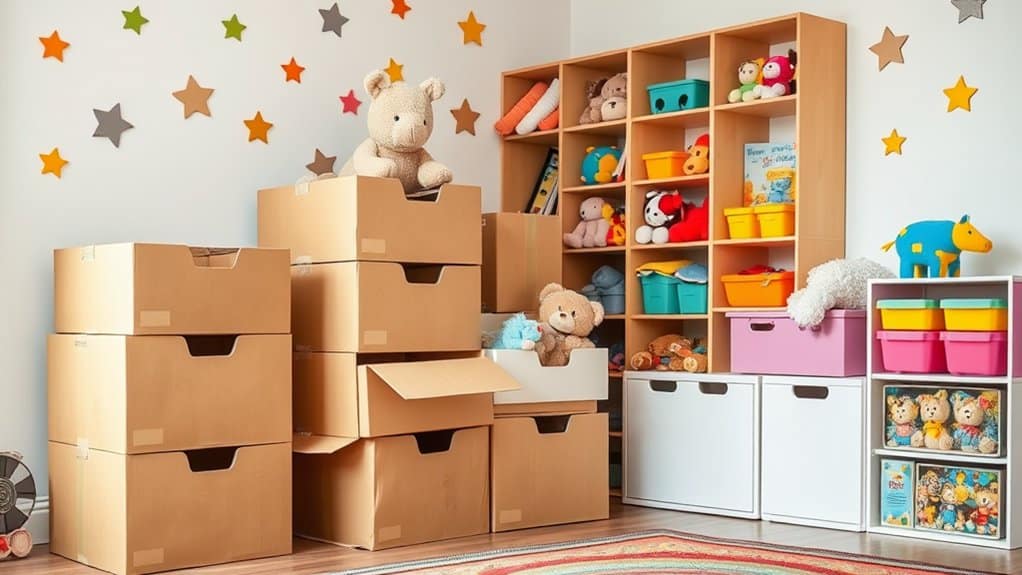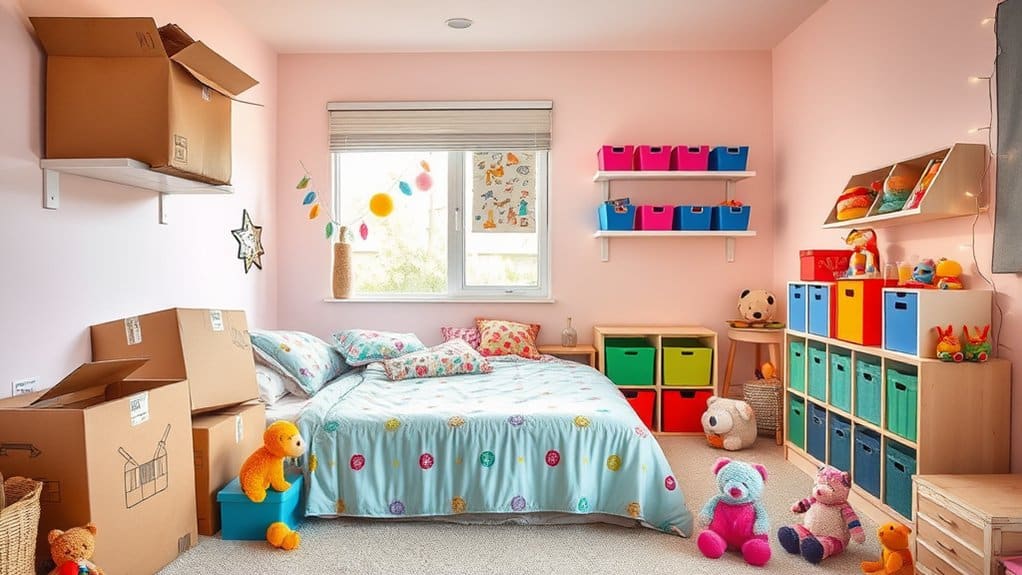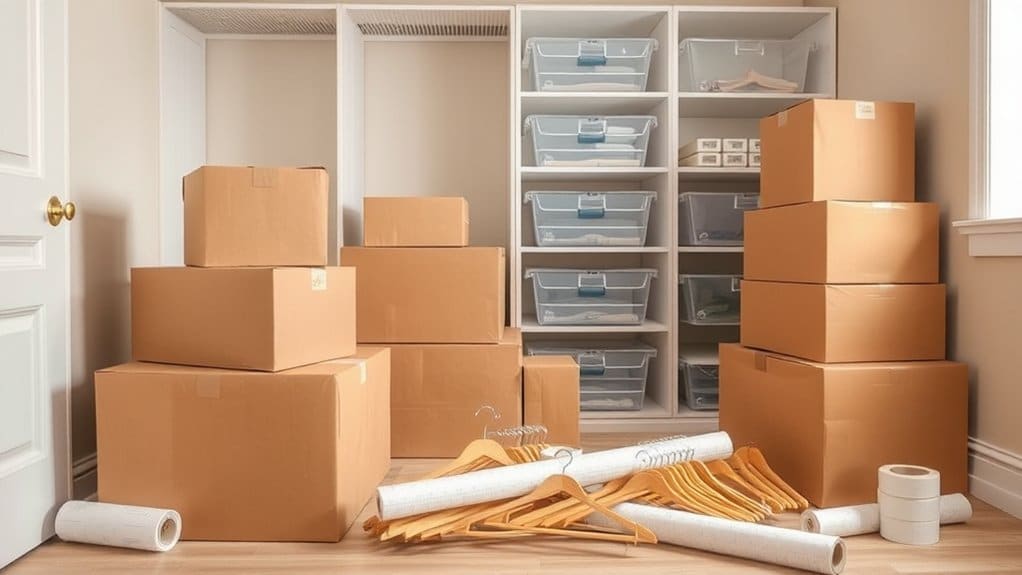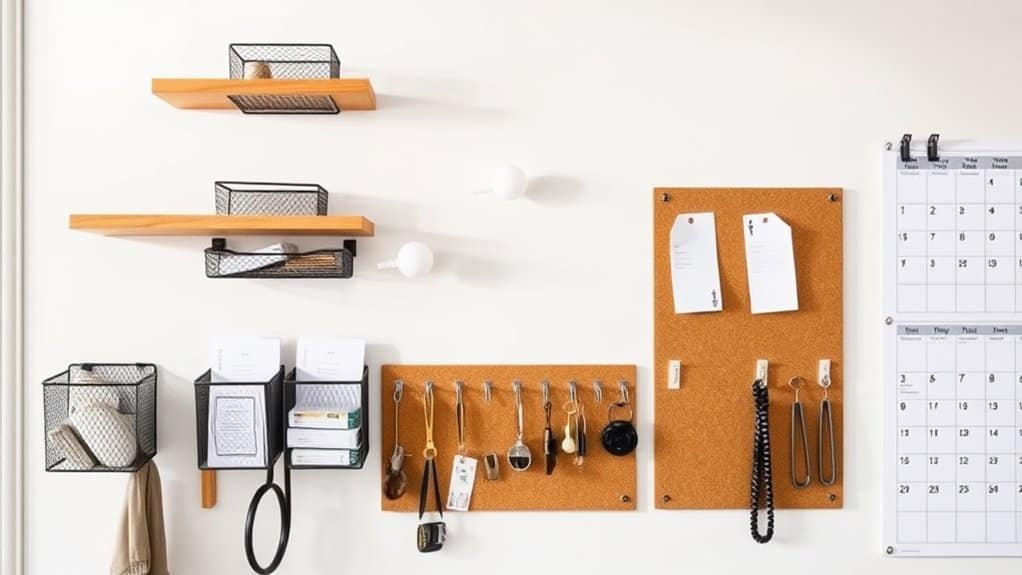Make unpacking with kids both enjoyable and productive by turning it into an engaging activity. Transform the process into a treasure hunt with checkpoints and hidden surprises, or create room-specific teams with age-appropriate tasks. Set up color-coded sorting stations with clear visual labels, and implement a reward system for tracking progress. Let children personalize their spaces by involving them in storage decisions and room layouts. These strategies will establish routines that make unpacking feel less like a chore and more like an adventure.
Turn Unpacking Into a Treasure Hunt

While moving can feel overwhelming, transforming the unpacking process into an exciting treasure hunt creates an engaging experience that'll keep your kids motivated and focused.
Start by designing treasure maps that guide them through designated areas of your new home, complete with numbered checkpoints and hidden clues leading to specific boxes.
Place small treats and surprises within boxes, and create riddles or instructions that link to particular items. You'll maintain engagement by incorporating interactive roles, like having your children play "detective" while searching for hidden treasures. Setting aside time to establish a routine helps create structure and security during the unpacking adventure.
Consider setting up staggered reveals where solving one puzzle releases access to new boxes or rewards. For added educational value, theme the hunt around classroom subjects, incorporating elements like science experiments or map-reading exercises throughout the adventure.
Creating Room-by-Room Unpacking Teams
Once you've mapped out your unpacking strategy, organizing your children into room-specific teams creates an efficient and engaging approach to settling into your new home.
Enhance team dynamics by letting kids select their room layouts and giving them control over organizing personal belongings. Assign age-appropriate tasks, with teens handling furniture placement while younger children sort toys and smaller items. This process can help children overcome nostalgia as they focus on creating a new environment.
Implement role rotation to maintain engagement and prevent boredom. Use color-coded labels and visual guides to help teams identify their designated boxes and spaces. Creating an unpacking party atmosphere helps turn the organizing process into an enjoyable experience.
Create progress boards to track completion, and consider pairing older siblings with younger ones for mentorship. Maintaining family routines during this time can also provide essential stability.
Don't forget to celebrate achievements with mini-rewards like snack breaks or movie night privileges after completing each room, reinforcing positive teamwork and maintaining momentum throughout the process.
Setting Up Kid-Friendly Sorting Stations
Transform your sorting stations into engaging zones by designating specific color areas with vibrant, visual labels that'll help your kids identify where items belong.
You'll want to attach clear, fun pictures to each sorting zone, making it easy for children to match objects with their designated spots without feeling overwhelmed.
Create simple team rules for the sorting process, such as "one item at a time" or "ask before moving between zones," which will help maintain organization while keeping your kids focused on their unpacking tasks. Additionally, consider unpacking children's items after essentials to provide a sense of familiarity during the transition.
Sort By Color Zones
Setting up color-coded sorting zones creates an intuitive system that helps kids tackle unpacking with confidence and enthusiasm. Start by designating specific areas using bright, high-visibility colors that enhance color recognition and make sorting activities more engaging.
You'll want to use primary colors for younger children and introduce secondary colors as their comprehension develops. Create clear boundaries with laminated mats or tape on flat surfaces, and position these zones in high-traffic areas where kids naturally gather.
You can repurpose plastic plates or clear containers for sorting items, making it easy for children to see their progress. Combine the zones with familiar household color schemes to boost recognition, and rotate the layout periodically to maintain interest.
Consider incorporating games like *I Spy!* to transform sorting into an interactive learning experience.
Label With Fun Pictures
Visual labeling transforms ordinary packing boxes into engaging sorting stations that captivate children's attention and streamline the unpacking process. You'll want to incorporate picture labels that combine clear text with playful cartoon themes, making it easier for kids to identify and sort their belongings.
Let your children participate in the labeling process by choosing their favorite characters or drawing small illustrations next to written descriptions. Create simple visual guides using universal symbols, like utensils for kitchen items or books for study materials.
Don't forget to add personalized touches with bright markers and stickers, allowing kids to mark their specific boxes with names and custom artwork. For shared spaces, use neutral icons that everyone can understand, such as a plant symbol for living room items.
Create Team Unpacking Rules
A successful unpacking strategy begins with clear team rules and well-organized sorting stations. Start by establishing teamwork expectations, assigning specific roles like "Label Leader" or "Sort Helper" to each child.
Create designated "Sorting Zones" for different item types, using color-coded bins and picture labels to make organization intuitive.
Set up your unpacking responsibilities with a structured approach. Establish sample stations labeled "Playroom," "Dresser Drawer," and "Scrap Heap" to guide children's sorting decisions. Include an "Oops pile" for items that need adult review, and implement a once-and-done rule to prevent constant reshuffling.
Keep the process moving smoothly by incorporating scheduled breaks and rotating roles periodically. This system helps maintain focus while ensuring each team member understands their part in the unpacking process. Additionally, consider exploring family-friendly neighborhoods in San Francisco to further engage your children in their new environment.
Rewarding Quick Wins and Progress

Tracking daily progress and celebrating small victories can transform unpacking from an overwhelming task into manageable, rewarding steps for your kids.
You'll want to set clear daily unpacking goals, such as completing specific boxes or areas, and use visual charts or sticker systems that children can easily understand and follow.
When your family reaches these smaller milestones, celebrate with immediate rewards like extra playtime or special snacks, which reinforces positive behaviors and maintains momentum throughout the unpacking process.
Celebrate Small Victories
When unpacking with children, celebrating small victories can transform a potentially overwhelming task into a series of rewarding achievements.
You'll want to establish celebration rituals that mark progress milestones throughout the process. Consider organizing quick dance parties when a room is finished, or sharing high-fives after completing specific tasks.
Make recognition immediate and meaningful by connecting rewards directly to effort. Praise your children's perseverance with specific comments like "You did an amazing job organizing those books!" or "Look how carefully you unpacked those dishes!"
Set up visual tracking systems, such as sticker charts or achievement boards, to document their progress. These tangible markers help children see their accomplishments while maintaining momentum throughout the unpacking process.
Track Daily Unpacking Goals
Building upon your celebration system, daily goal tracking provides a structured framework to maintain momentum throughout the unpacking process.
Set up a visual tracking system using colored magnets on a Kanban board or create digital checklists in apps like Trello to monitor your family's progress effectively.
Break down your unpacking goals into small, manageable tasks that you and your kids can tackle each day. Use progress tracking tools to mark completed items with green markers or digital checkmarks, making goal visualization clear and engaging for children.
Schedule regular 15-minute family reviews to assess what you've accomplished and plan the next day's tasks.
Consider implementing a simple reward system where kids earn points or privileges for maintaining consistent unpacking habits and meeting their daily targets. Additionally, taking time to declutter your belongings before moving can significantly streamline the unpacking process and make it more enjoyable for everyone involved.
Making Their Space a Priority

Creating dedicated spaces for children during the unpacking process helps establish a sense of security and normalcy in their new environment.
You'll want to prioritize space personalization by letting your kids take ownership of their rooms through unpacking creativity and child involvement. Set up designated areas where they can organize their belongings while making the process fun through family collaboration.
Transform organizing into an imaginative storage adventure by implementing child-friendly zones where they can arrange their toys, books, and clothes.
You can establish peer learning circles where siblings help each other unpack and arrange items. Consider setting up sustainable play areas that they can access during breaks from unpacking.
Don't forget to incorporate their input on furniture placement and room layout, as this strengthens their connection to their new space. Additionally, encourage them to explore activities in Los Angeles that they can enjoy once the unpacking is completed, which will help them feel more excited about their new home.
Establishing New Storage Systems Together
A well-organized storage system forms the backbone of a smooth unpacking process with children.
Start by evaluating your available space and identifying essential storage needs for toys, books, and creative materials. You'll want to purge unused items before implementing new storage solutions, making the organization process more manageable.
Embrace collaborative design by letting your kids participate in choosing storage colors and labels that reflect their interests.
Create distinct zones using low storage for frequently accessed items and wall units for seasonal toys. You can make the system more engaging by incorporating playful elements like color-coded bins with themed stickers.
Don't forget to implement clear labels using large fonts or icons, ensuring your children can easily identify where items belong and maintain the organization independently.
Building Routines Through Organized Play
While establishing new habits can feel challenging, you'll find that turning unpacking into organized play creates lasting routines that stick with your children. Through play-based learning, you can transform mundane tasks into engaging activities that reinforce systematic thinking and organizational skills.
- Create a "completion collection" game where kids gather similar items from different boxes to earn points.
- Set up visual tracking boards with colorful magnets to monitor progress.
- Establish designated unpacking zones, like kitchen islands, for routine reinforcement.
- Design mini-challenges with sticker rewards for specific sorting tasks.
Turn daily shifts into opportunities for structured learning by incorporating gamification strategies. As your children race to complete their unpacking missions or solve item-sorting puzzles, they'll naturally develop efficient habits while having fun.
Conclusion
Studies show that children who participate in household organization tasks are 40% more likely to develop strong executive functioning skills. By turning your unpacking process into an engaging family activity, you'll not only complete the move-in faster but also help your kids build essential life skills. When you create positive associations with organization early on, you're setting your children up for long-term success in managing their spaces and responsibilities.






